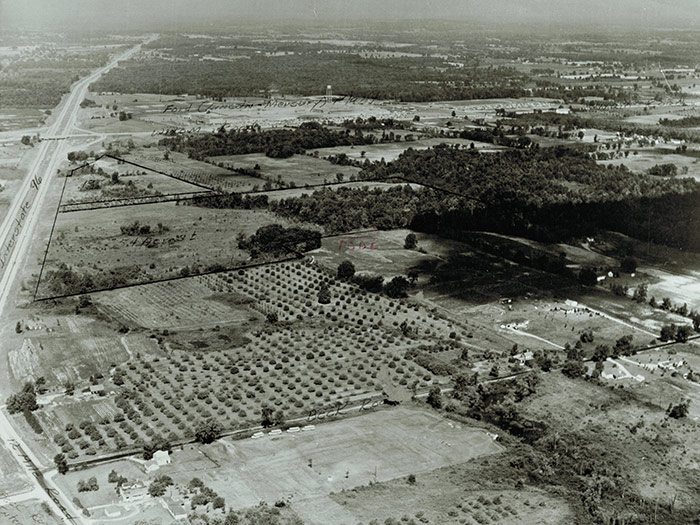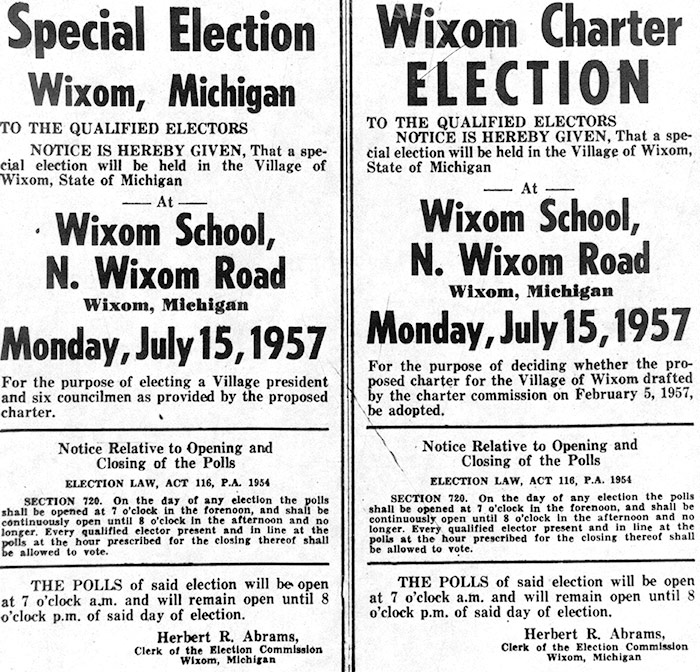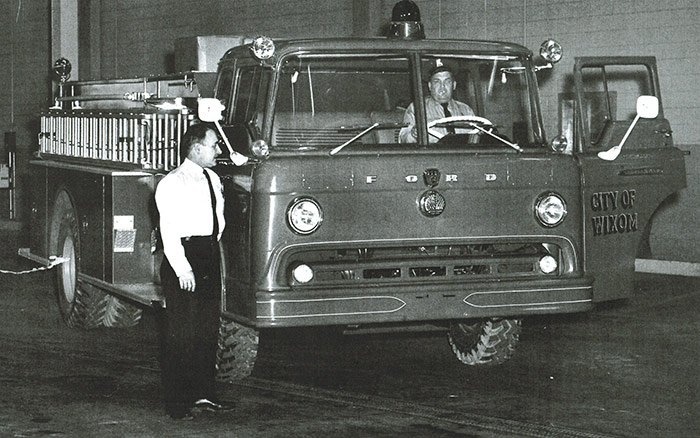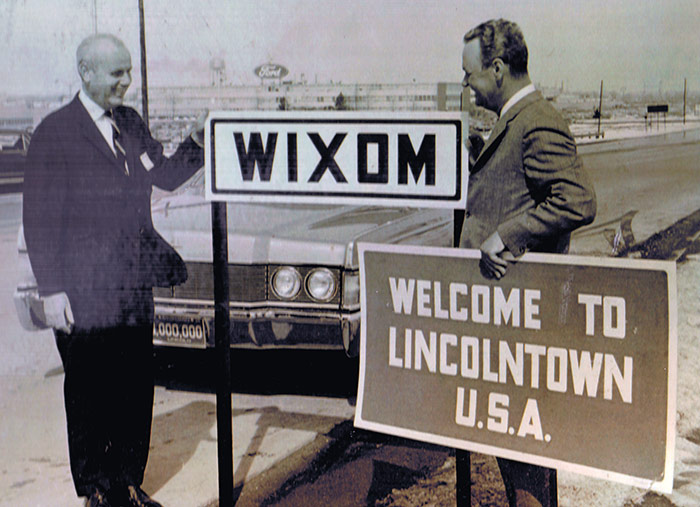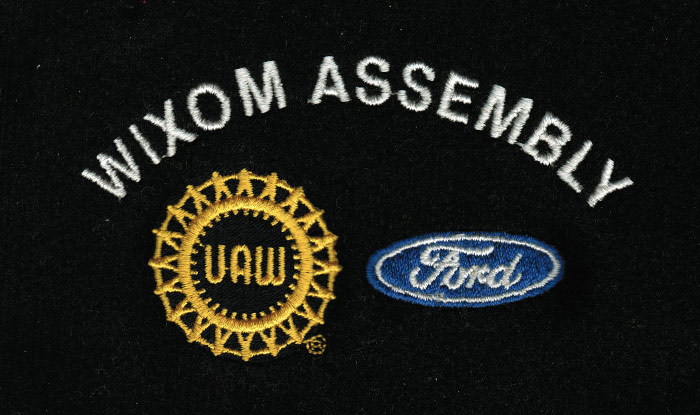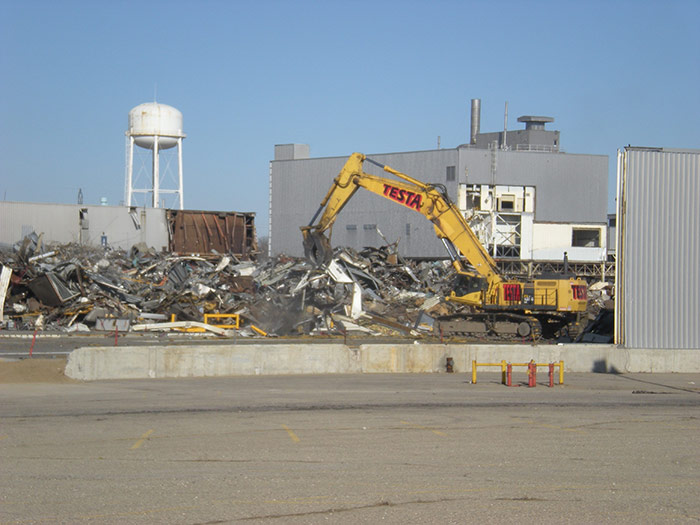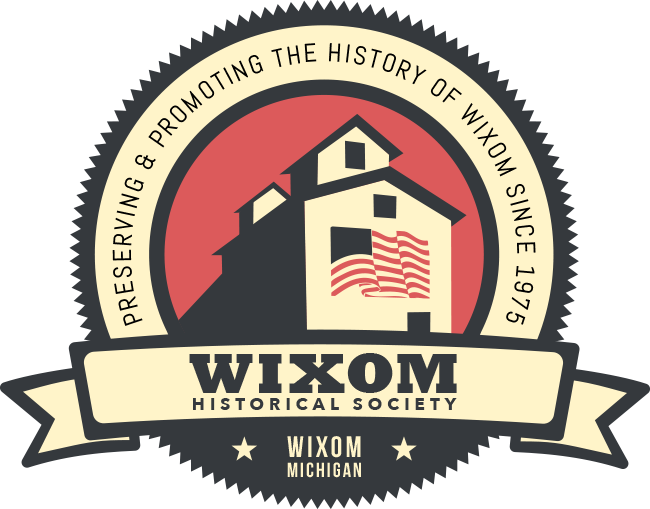Early Settlers
In 1830, seven years before Michigan became a state, Lewis Norton arrived in the area now known as Wixom; although he did not stay here permanently, he is credited as being Wixom’s first pioneer. Norton Creek is named for him.
In May 1831, the man who would become Wixom’s first permanent white settler arrived in the Territory of Michigan, traveling via the steamer “Sheldon Thompson.” Twenty year old Alonzo Sibley settled in Commerce Township, on land today described as north of Maple Road and east of Wixom Road. He purchased 80 acres at $1.25 per acre. The deed for his property was signed by President Andrew Jackson. As a successful farmer and businessman, Alonzo Sibley acquired additional lands until his property totaled 350 acres. Sibley was a philanthropist; he donated some of his property for a local cemetery in 1837. The cemetery was initially called the South Commerce Burial Ground, but it is now named Wixom Cemetery. Alonzo Sibley became president of the cemetery association. He was also a trustee and lifelong deacon of the Free Will Baptist Church of Commerce, which he helped to organize in 1838. In June of 1864, Sibley donated another piece of land, for the church building. Hillsdale College’s President Edmund Fairfield dedicated the new church. The locale that Alonzo Sibley established became known as “Sibley’s Corners.” Sibley was a very active citizen, as he was also a county assessor, highway commissioner, and justice of the peace. (Alonzo Sibley is featured in the book, Biographical Sketches of Leading Citizens of Oakland County Michigan, 1903, pp. 42-44.)
Meanwhile, in 1832, Mr. and Mrs. Ephraim Burch and their family also settled in the area. They purchased three parcels of land from the government totaling 200 acres. The first two properties were located in the area we now call Charms Road. The deeds were signed by President Andrew Jackson in 1832. The deed to the third property was signed by President Martin Van Buren in 1837. It is located south and west of Wixom Road. Ephraim’s wife, Electa (nee Sessions) united with the Free Will Baptist Church when it was first organized in 1838, as the First Free Baptist Association of Commerce. Ephraim was a trustee of the cemetery association.
Daniel Johnson Sr. purchased parcels of land from the federal government in 1832, 1835 and 1837. The properties, totaling nearly 160 acres, were located in section 7 of Novi Township. The deeds for the first 2 properties were signed by President Andrew Jackson; the third deed was signed by President Martin Van Buren. Johnson built a large farm, and also worked as a blacksmith; his son Daniel Johnson Jr. later continued to cultivate the land. A portion of the Ford Wixom Assembly Plant would later be located here.
Another early pioneer, Ahijah Wixom, arrived in the area around the same time. He and his wife Lucy settled in Commerce Township, initially purchasing land in the area we refer to today as south of Maple Road and east of Wixom Road. The family home was located near Norton Creek. Ahijah served as secretary of the cemetery association before his death in 1855. The same year that Ahijah died, Mrs. Wixom had a home built for the use of Rev. Samuel Wire, who was pastor of the Free Will Baptist Church, and his wife, Mrs. Lucy Wire. Electa Burch purchased the house from Mrs. Wixom in 1872. After Mrs. Burch’s death in 1897, Mr. and Mrs. William Tiffin bought the house; members of the Tiffin family resided there until 1973. This historic home is still standing in its original location and is now a museum and state historic site known as the Wixom-Wire House.
Pioneer James Sandford arrived in the area in 1833. He purchased a large amount of land in sections 4, 5, 8, and 9 of Novi Township (now known as the area of Beck Road and West Road in Wixom) as well as an entire section of Reading Township in Hillsdale County MI. Sandford and his wife Margaret had a daughter Caroline, who would later marry Abel G. Peck. In 1863, Color Sergeant Abel Peck would be killed in the Battle of Gettysburg. The Pecks’ daughter, Alice, later became the wife of Willard Wixom, son of Ahijah and Lucy Wixom.
Local Participation in the Civil War
1861 marked the beginning of the Civil War. Michigan Governor Moses Wisner, whose term of office was 1859 to 1861, was asked by his successor to form a regiment of Union soldiers from Michigan after leaving office. Wisner responded by raising Michigan’s Twenty-Second Infantry, mostly with men from Oakland and Macomb counties. Many men from Sibley’s Corners, Commerce Township, and Novi Township enlisted and became part of Company I, including local residents Albert Baker, Warren Baker, Marvin Bogart, James Calhoun, Thomas Calhoun, Daniel Johnson Jr., Oscar Kelsey, William H. Merithew, Seth Noble, John L. Roberts, and Watson Sibley. Nearby residents that enlisted include Homer Parker (Lyon Township), Noah Eckler (Lyon Township), and William Lambert (Milford Township). The men of Michigan’s Twenty-Second gathered in Pontiac and left September 4, 1862.
Michigan’s Twenty-Second Infantry fought in the Battle of Chickamauga, September 18-20, 1863. Bogart, Johnson, and Albert Baker were captured by the Confederate Army. Albert Baker died one month later from wounds received in battle and is buried in Chattanooga National Cemetery. He is the only known Wixom resident to die during the Civil War. Bogart and Johnson survived, despite enduring horrific conditions at the notorious Andersonville Prison Camp.
In addition to local residents, friends and family members that lived elsewhere but were known to the community entered the war. One such person was Abel Peck (Company C Michigan 24th Infantry), whose wife Caroline (nee:Sandford) grew up in northwest Novi Township (now Wixom). Peck was killed in the Battle of Gettysburg. He is buried at Gettysburg National Cemetery.
After the war, some of the local veterans moved elsewhere, but Noble, Merithew, Johnson, and Bogart remained residents of Wixom for the rest of their lives. Roberts stayed in the area, living at various times in Milford and Wixom. In addition, other Civil War Union Army veterans made Wixom their home after the war, including Justus Beebe (Company G Michigan 8th Infantry), Daniel C. McGuire (Company K Engineers and Mechanics), Silas N. Parker Jr. (Company H Michigan 4th Infantry), and George D. Spencer (Company F Michigan 30th Infantry). Most of the men joined the veteran’s organization, The Grand Army of the Republic (GAR). Women became members of the Women’s Relief Corp (WRC).
At least eight Civil War veterans are buried in Wixom Cemetery, including Justus Beebe, Marvin Bogart, Daniel Johnson Jr., William Lambert, Daniel McGuire, William Merithew, Seth Noble, and Silas Parker Jr.
Michigan’s Twenty-Second Infantry had a mascot of sorts, a cowbell. The bell was taken from a cow by some of the enlisted men as they headed to Pontiac before the war, and was adopted by the whole regiment. It was rung to wake the men in the morning, call them for meals, signal bed-time, motivate them before battle, and to lift their spirits. After the war, it was brought to the veterans’ reunions.
There are several versions of the story as to the origin of the bell. Some said it came from Pontiac, others claimed it was from New Hudson, still others believed it was acquired from a farm near Pine Lake or Orchard Lake. All agreed it began with men from Company I. Evidence indicates that the men and the cowbell came from the Wixom-Walled Lake area. The Milford Times published a story on August 30, 1879 that states the bell was “borrowed” by Watson Sibley, Warren Baker, Reuben C. Smith, Thomas Manypenny, Henry Lyon, Noah Eckler, and brothers James and Thomas Calhoun. The newspaper reported that they took the cowbell from the neck of a cow belonging to 62 year old farmer Samuel Williams on September 3, 1862, the day before Michigan’s 22nd Infantry gathered in Pontiac. These men, all from Company I, related their story at the annual Old Soldiers’ Reunion in August 1879, which was held that year in Wixom to honor Michigan’s 22nd Infantry and 8th Cavalry.
Sibley, Baker, and the Calhoun brothers had been neighbors in Sibley’s Corners at the time that they enlisted in the Union Army. Sibley’s father, Alonzo, owned property directly east of the Calhoun farm. Baker had been a laborer at the neighboring Willard Wixom farm. The Calhouns’ father owned additional farmland near Sam William’s farm in Commerce Township, near Walled Lake. Noah Eckler had been a laborer at the nearby Jay Marlatt farm in Lyon Township, southwest of Sibley’s Corners. Smith and Manypenny were residents of Hartland, though both enlisted from Lyon for reasons unknown at this time.
James Calhoun had possession of the bell after the war; he brought it to the 1879 reunion. Later, the cowbell would find its way to fellow Michigan 22nd Infantry veteran and Wixom resident Marvin Bogart. An April 1934 Detroit newspaper story about Bogart states that the cowbell was one of his most prized relics. By that time, 94 year old Bogart, one of the last surviving veterans, recalled the cowbell as coming from a farm near Pontiac.
The cowbell is now in the possession of the Oakland County Pioneer and Historical Society and can be seen at the Governor Moses Wisner Home in Pontiac. It is engraved, “This bell was taken from a Cow’s Neck by Members of Co. I 22nd Michigan Vet. Infantry September 3, 1862 and was rung in every camp and battle the regiment had during the beginning and end of every day.”
Wixom & Sibley
Sibley’s Corners was the center of town until 1871, when the son of Ahijah and Lucy Wixom, Willard Clark Wixom, gave right of way passage through his property to the Holly Wayne and Monroe Rail Road. (It later became known as the Pere Marquette, then the Chesapeake and Ohio, and is currently the CSX.) He also platted the town through his property. When the Michigan Airline Railroad (Grand Trunk Western) came through the town in 1883, it formed an important railroad junction. Willard Wixom then located the railroad station, union depot (1885), and mail drop on his property at the intersection. This bustling area just south of Sibley’s Corners became known as Wixom Station, then eventually Wixom. In 1887, one of 58 signal services appropriated to Michigan by Congress was located at Wixom Station. The railway gave the community shipping advantages for handling farm production.
During this time, the United States was in the midst of the Industrial Revolution. Willard Wixom understood that factory workers and their families in cities needed food supplies to be brought to them from farms. He knew his community had the opportunity to become the hub of commerce in Michigan, due to the railroad junction and good farm production. Being a nationally recognized shorthorn cattle breeder, Wixom was able to capitalize on his reputation. Wixom formed a highly prosperous business partnership with Judson L. Sibley, son of Alonzo and Sarah Ann (nee Heath) Sibley. Sibley & Wixom excelled in the grain, produce and lumber business, establishing a mill and storage depot in 1871. It became one of Michigan’s largest grain and produce handling points. The business lasted nearly 30 years.
Judson Sibley valued knowledge in addition to his business ventures. He was the 212th graduate of Hillsdale College. Understanding the importance of a good education, he then served as Director of Wixom Standard School. While partaking in the successful business partnership with Willard Wixom, Sibley also became supervisor of Commerce Township, a position he held for seven years.
On Christmas Eve 1901, the residents of Wixom were stunned and saddened when Willard Wixom was struck by a passenger train and killed while crossing the railroad tracks in his horse and wagon. It was an ironic twist of fate for the man for whom the community was named.
On October 12, 1902, the Judson Sibley family home was destroyed by fire. The stately 10 room home had been located on what is now the north side of Pontiac Trail, east of Wixom Road. After the losses of his friend and home, Sibley and his family moved to Pontiac. He became Treasurer of Oakland County in 1903. (Judson Sibley is featured in the book, Biographical Sketches of Leading Citizens of Oakland County Michigan, 1903, pp. 93-95.)
Later, another kind of Sibley and Wixom partnership was formed. Sibley’s son Harry married Wixom’s daughter Alice on June 7, 1911.
Farming
Farming was central to Wixom life, winning many accolades for local residents. In September 1888, Willard C. Wixom won 9 first place and 6 second place awards at the Flint MI fair. The Eclipse Cheese Factory’s Dr. Justus Beebe and Mr. Robert McKinney were awarded first place for their cheese at the State Fair in 1890, beating out competition from as far away as Ohio and New York. In the mid 1890’s, local resident Nathan A. Clapp served as one of the vice presidents of the American Berkshire Association. He exported “porkers” to many places, including Africa. In 1896, Wixom’s A.N. Kimmis Jr. was elected president of the State Association of Farmer’s Clubs. In 1899, Willard Wixom was elected vice president of the Michigan Shorthorn (cattle) Breeder’s Association.
In March of 1895, the Wixom Union Farmer’s Club was organized with an initial membership of 23 families. Soon, more than 100 people regularly attended the monthly meetings. The local group exchanged ideas, offered farm items for sale, and kept each other informed. They initiated the Wixom Fair in 1909. By 1911, the fair had over 200 exhibits. At the 1914 fair, displays were judged by staff from Michigan Agricultural College (Michigan State University) and Michigan Farmer Magazine. The village of Wixom was featured in an issue of the magazine.
The 1918 Wixom Fair was cancelled because of a ban on public gatherings due to the devastating influenza pandemic. None-the-less, several days later, residents gathered in the streets to celebrate the end of World War I, while the town bells rang in joy.
A Flourishing Community
The end of the Civil War, and later, the arrival of the railroad, brought residents and visitors to Wixom. Still, many people traveled by horse and buggy. One year after the Holly, Wayne and Monroe Railroad was finished, a hotel was built at what is now the southwest corner of Wixom Rd and Pontiac Trail. It stood more than 50 years, from 1872 until it was demolished in 1936. A livery stable was located behind it.
In August 1879, Civil War Veterans from the Michigan 22nd Infantry and the 8th Cavalry held a reunion in Wixom. Thousands attended; more than 1500 people ate lunch at the grove west of Willard Wixom’s home–a meal which was prepared and served by the citizens of Wixom.
Michigan was one of the states to have an Anti-Horse Thief Association. The state association had officers in each county, who selected riders in each locale. After a horse went missing, the owner notified the local rider and sent a message via telegraph to the county officer. Officials passed the word to other locales. The roads were watched and circulars were passed out. When thieves were spotted, the riders chased them and passed the information to the next locale if needed. By 1880, the Southwest Oakland County Anti-Horse Thief Association was established in Wixom. A one-hundred-dollar reward was paid to Frank Vowles and (Phil) Parker for capturing a horse thief in August of 1885.
Wixom, like many small towns, had a cornet band. The Wixom Cornet Band was organized in the summer of 1880. Some members were S.W. (or A.W.) Arms, B.F. Brooks, Dave H. Calhoun, William M. Chambers, George Dickerson, J.E. Estes, Eugene B. Furman, John Garte (or Goite), Oscar Kelsey (2nd B flat cornet), S. Kinsman, John Law, Frank S. Madison, George B. Madison, Gilman (AKA J.G. or Gilbert) Madison (Drum major), Ben W. Munshaw, Frank B. Munshaw, George Perrigo, George W. Pittenger, John R. Rauch (clarinet), Charles A. Tuck, and Fred Van Hoven.
In 1880, William M. Chambers and his brother James B. Chambers opened a successful foundry and machine business in the center of town, primarily forging plows for the agricultural community. Despite being severely injured in an industrial accident at the foundry in 1882, William continued partnering with his brother in the foundry business approximately 15 years. A trusted and well respected individual, William was appointed postmaster of Wixom in November of 1887, after the death of Wixom’s postmistress, Mrs. H.S. Johnson. J.B. Chambers’ arms were seriously burned while smelting iron in 1894. The two brothers established the Chambers Brothers Hardware Store circa 1894. Their store provided many of the supplies needed to build and repair many Wixom buildings, including the Free Will Baptist Church in 1897. (William Chambers is featured in the book, Biographical Sketches of Leading Citizens of Oakland County Michigan, 1903, pp. 429-430.)
In August of 1888, there was talk of a cheese factory being established in Wixom. Two hundred cows were guaranteed. By 1890, Justus Beebe and Robert McKinney of the Eclipse Cheese Factory were shipping cheese; the patronage doubled in only one year. Hiram Johns and Seth Nicholson bought the cheese factory in November 1890. In the spring of 1892, Mr. Jenkins was the cheese maker. Harmon A. Smith of Plymouth, MI bought the cheese factory in the fall of 1892. By July 1893, he was shipping cheese and milk to Detroit, most of it in wooden cheese barrels. A new cheese press was added in 1899. Smith, a member of the Wixom Union Farmer’s Club, with help from his wife Maggie, remained the owner of the Smith Cheese Factory for nearly 35 years, until approximately 1925.
In addition to businesses, social groups were a big part of early Wixom life. A tent of the Knights of the Maccabees (K.O.T.M.) was organized in Wixom in March of 1890. The members of Maccabees provided life insurance for each other; social activities were an added bonus. By July 1990, the Maccabees had made plans to build a hall on the site of the “old harness shop”. The 60′ x 20′ foundation was laid by George Stevens. Fred Childs supervised the building of the hall; E. Groner was the plasterer. The first meeting in the hall was held September 15, 1891. Wives and daughters from the Ladies of the Maccabees joined the important meeting and celebration, for a total of about 100 people.
Education was important to the community. Early residents sent their children to the little red schoolhouse in Sibley’s Corners. In 1888, Judson L. Sibley was re-elected as the director of the school. Wixom Standard School, with 2 classrooms, was built in 1891, with William Roberts as the contractor. Students primary through 8th grade attended this school. Some early Wixom teachers included: Miss Minnie Wells (1885), Miss Hattie Madison (1887), Miss Bicking (1888, 1890), Mr. Charles Wixom of Farmington (1892), Mr. Charles W. Soulby (principal and teacher 1892-7), Miss Nina McCain (1895), Miss Allie Wixom (1897), Mr. Severance of Walled Lake (charge of primary department 1899), and Miss Fergusson (teacher of primary department 1899). Student performances assisted in raising funds for classroom supplies including a classroom globe (1890), dictionary (1895), and library (1899). A school flag was purchased in 1892.
By 1896, Wixom residents were showing off their “wheels.” James Chambers, N.W. Ball, and William Griffiths are the first Wixom residents known to have bicycles in Wixom. Times were changing. In June of that year, a resident suffered an injury after a horse became frightened by a passing cyclist. In 1899, Wixom hosted a 4th of July Bicycle Race, with several hundred people attending. The winners were Will Chamberlain, Hart Lambert, and Fred Harland.
Women were active in improving the community. The Ladies Sidewalk Society was organized on December 17, 1898, initially for the purpose of raising funds for a boardwalk from the village to the church. Fund raising activities included bake sales, maple syrup sales, ice cream socials, and quilting projects. When that task was completed, they raised funds for a cemetery fence, which was erected in December 1899. Portions of the original cemetery fence remain to this day.
In 1916, 22 enterprising men bought Wixom & Sibley’s mill and formed the Wixom Cooperative. Additional land was purchased and a new and larger elevator was built Major commodities were seed and grain. It was located on the north side of Pontiac Trail, just west of Wixom Road, at the railroad tracks. Years later, On September 27, 1992, thousands gathered at the site of the Co-op, to greet President George H.W. Bush and Mrs. Bush. The train brought the President and his wife to town during his “whistle stop” presidential re-election campaign. Ten years later, in June 2002, the Co-op elevator, a distinct landmark in the community, was torn down.
December 1925 brought a disastrous fire, which all but obliterated the bustling Wixom community. That morning, a fire destroyed the Pere Marquette water tank (built in 1898) and pump house. A second fire was discovered early in the afternoon. Ray Abrams was the first to spot the second fire; his quick action saved much of the mail in the post office. Surrounding communities arrived with help. Walled Lake brought a fire truck, but was unable to help much because the pump was frozen. Northville and South Lyon brought their fire engines, but there was not enough water to fight the flames. Strong winds carried burning embers, so chemicals were used to save several homes. Among other buildings, Chambers Brothers Hardware Store and adjacent Petteys’ General Store (including the Petteys family home) were total losses. The community hall and auditorium were located on the second floor of Petteys’ building; they too were in ruins. The fire was thought to have been caused by an overheated furnace. The inferno, jumping from building to building, brought the village to its knees, erasing its place of leadership within the state.
The Free Will Baptist Church
Pastor Cephas P. Goodrich organized the Free Will Baptist Church of Commerce on March 21, 1838, along with local families including Mr. and Mrs. Alonzo (Sarah Heath) Sibley, Mr. and Mrs. Daniel Curtis, Mr. and Mrs. James Baird, Mr. and Mrs. Woody Fletcher, Mr. and Mrs. Lyman Bennett, and Mrs. Electa Burch. Mr. Fletcher and Mr. Sibley became deacons when the church was organized. Mr. Fletcher was also the clerk. Initially they met in homes, but in 1854, they started meeting in the little red schoolhouse that was located in what is now Wixom Cemetery. In 1855, Mrs. Lucy Wixom had a home built for Reverend Samuel Wire, who was pastor from 1853 to 1860. The home, located on the southwest corner of Wixom Road and Maple Road in Sibley’s Corners, is now known as The Wixom-Wire House. It is a designated Michigan Historic Site.
In 1864 a permanent church was erected. Jackson Underwood was the builder; the cost was $625. The trustees that signed the contract were George Clark, William A. Smith, William H. Burch, M.R. Fletcher, M.G. Porter, and Ephraim Burch. Deacon Sibley was instrumental in obtaining the church bell. The new church was dedicated on January 12, 1865, with President Edmund Fairfield of Hillsdale College officiating. Immediately following the dedication, Deacon and Mrs. Sibley’s daughter Harriet was married in the church to Pastor James Drew.
From the beginning, members of the church were active in social issues. The Ladies Aid Society provided assistance to local families in times of need. Temperance became a popular topic among the devout, largely Baptist Wixom community. The church hosted passionate speakers that motivated the people to action. They formed a Red Ribbon Club in August of 1880, followed by a local Women’s Christian Temperance League in April of 1886. The County convention of the W.C.T.L. was held in Wixom that year. The youth of the congregation were also active in the community. The young people organized a local club of The Band of Hope, in September 1886, encouraging abstinence and healthy living.
In October 1897, the church building was moved from Sibley’s Corners (where the southern part of the cemetery is), across Maple Road to the center of town in Wixom. It took two weeks to move, and was accomplished with the help of horses and rolled logs. Many local residents participated in the move and renovations after the move. (The Wixom Historical Society maintains a collection that includes names and payment records of those involved. Contact WHS for more information.) After the move, the church was located where Wixom Elementary School stands today. In 1927, local resident and Civil War veteran Marvin Bogart, who joined the church in 1884, donated the church baptistery. Prior to that, baptisms took place in the nearby creek or pond, cutting through ice if necessary, according to the “Recollections of Gertrude Sibley”. In 1960, a new church building was constructed on the east side of Wixom Road, and is still home to a vibrant congregation. It is now known as the First Baptist Church of Wixom. In 1966, the old, historic church building was torn down.


